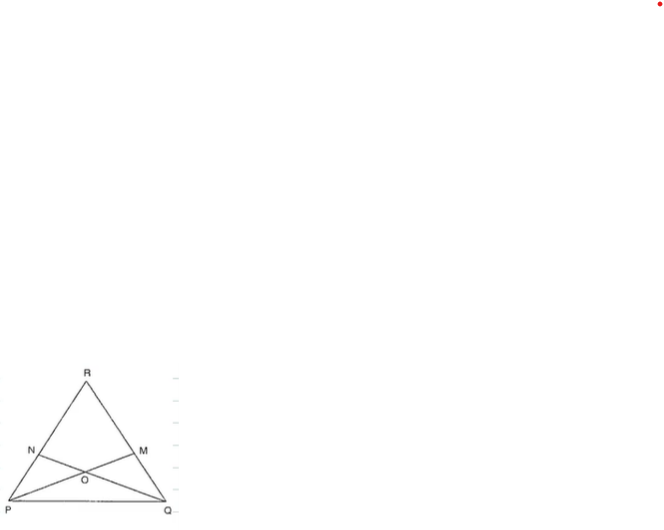In △OPQ right angled at P, OP=7cm , OQ−PQ=1cm . Determine the values of sinQ and cosQ .
To solve the problem, we need to find the values of sinQ and cosQ in the right-angled triangle △OPQ where OP=7cm and OQ−PQ=1cm.
1. Identify the Triangle and Given Values:
- We have a right-angled triangle △OPQ with the right angle at P.
- Given OP=7cm (which is the perpendicular side) and OQ−PQ=1cm.
2. Assign Variables:
- Let PQ=xcm.
- Then, from the condition OQ−PQ=1, we have OQ=x+1.
3. Use the Pythagorean Theorem:
- According to the Pythagorean theorem:
OQ2=OP2+PQ2
- Substituting the known values:
(x+1)2=72+x2
4. Expand and Simplify:
- Expanding the left side:
x2+2x+1=49+x2
- Now, subtract x2 from both sides:
2x+1=49
5. Solve for x:
- Rearranging gives:
2x=49−1
2x=48
x=24
6. Calculate OQ:
- Now substitute x back to find OQ:
OQ=x+1=24+1=25cm
7. Find sinQ and cosQ:
- By definition:
- sinQ=OppositeHypotenuse=OPOQ=725
- cosQ=AdjacentHypotenuse=PQOQ=2425
Final Answers:
- sinQ=725
- cosQ=2425
- We have a right-angled triangle △OPQ with the right angle at P.
- Given OP=7cm (which is the perpendicular side) and OQ−PQ=1cm.
- Let PQ=xcm.
- Then, from the condition OQ−PQ=1, we have OQ=x+1.
- According to the Pythagorean theorem:
OQ2=OP2+PQ2
- Substituting the known values:
(x+1)2=72+x2
- Expanding the left side:
x2+2x+1=49+x2
- Now, subtract x2 from both sides:
2x+1=49
- Rearranging gives:
2x=49−1
2x=48
x=24
- Now substitute x back to find OQ:
OQ=x+1=24+1=25cm
- By definition:
- sinQ=OppositeHypotenuse=OPOQ=725
- cosQ=AdjacentHypotenuse=PQOQ=2425
- sinQ=725
- cosQ=2425
Topper's Solved these Questions
Similar Questions
Knowledge Check
The resultant of two forces P and Q is at right angles to P, the resultant of P and Q' acting at the same angle is at right angles to Q'. P is
AA.M.BG.M.CH.M.DNone of Q and Q'If P:Q=9:7, then what is the value of (P−Q):(P+Q)?
A1:2B1:8C1:4D2:13
In ΔOPQ, right-angled at P, OP = 7 cm andOQ − PQ = 1 cmDetermine the values of sin Q and cos Q.
View SolutionIn ΔPQR,right-angled at Q (see figure), PQ = 3 cm and PR = 6 cm. Determine ∠QPRand ∠PRQ
View SolutionIn Figure, ∠QPR=∠PQR and M and N are respectively on sides QR and PR of PQR such that QM=PN . Prove that OP=OQ, where O is the point of intersection of PM and QN.

View SolutionPQRS is a square such that PR and SQ intersect at O. State the measure of ∠POQ
View SolutionIn Figure, PQRS is a parallelogram, PO and QO are, respectively, the angle bisectors of ∠P and ∠Q . Line LOM is drawn parallel to PQ . Prove that: PL=QM (ii) LO=OM
View SolutionABC is a triangle and PQ is a straight line meeting AB in P and AC in Q . If AP=1cm , PB=3cm , AQ=1.5cm , QC=4.5m , prove that area of APQ is one-sixteenth of the area of ABC .
View Solution
